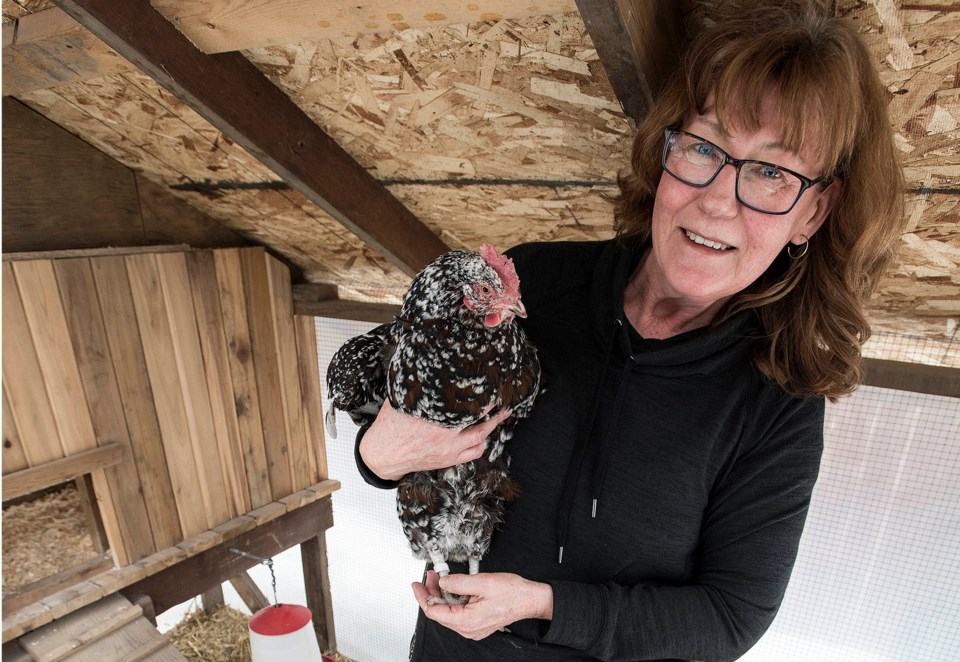Winter can be a bitter season, but thanks to good chicken-keeping practises, the hens in Christal Myner’s and Joanne Gleason’s back yards kept cosy all season long.
Both households have winterized chicken coops nestled behind their homes, stiff plastic wrapping the lower halves of the coops to keep out wind. Inside the structures, light, warmth and the happy clucking of chickens fill the air.
Myner and Gleason are two of the three participants who were selected last summer to take part in the City of St. Albert’s backyard hens pilot project. It’s been a year since the city closed applications to the project, which is now into its final months, and the project will officially wrap up in June.
Lenore Mitchell, senior planner for the city, says the wrap-up will be followed by a report and recommendation to city council, who will have ultimate authority over whether St. Albert’s feathery friends are here to stay. In the meantime, participants will be able to hang on to their hens until a final decision is made.
From Myner’s and Gleason’s front yards, you’d never know the chickens existed. The birds cluck softly – quieter than most household pets – and any chicken-coop smell is contained to the coop and can be easily managed if you clean the coop regularly.“It’s a lot of fun, and once you have the coop set up, they don’t take much work,” said Myner.
For her and her husband Pierre, caring for their hens has been like getting to know three new pets. The couple has owned backyard hens for years and previously took part in Edmonton’s hen pilot before they moved to St. Albert two years ago.
The timing, Christal says, was perfect: the pilot program came along shortly after they moved here, and they jumped at the chance to resume their hen-keeping activities.
After being accepted into the program, they chose four Silkie bantam hens – a hardy breed with five toes, black skin and furry feet. The birds have a shock of feathers on their heads and thick down coats to protect them from winter’s cold.
They make a special clucking noise when they’re fed their favourite mealworm snack, they frolick in the dirt, and they’re a big hit with the neighbours.
Each has their own personality: dark-brown Midge is at the top of the pecking order (“No one pecks her,” Pierre says); caramel-coloured Beeker is the tomboy; and lily-white Daisy is the defender. Their fourth silkie, Opal, didn’t survive the winter; Christal and Pierre are deciding whether to replace her.
Silkies are smaller than the Speckled Sussex hens Gleason keeps. Hers have a comb on their heads and mottled brown-and-white feathers.
“They love ants and eating dandelion greens,” Gleason said. Like the Silkies, they’re also a fan of mealworms.
Gleason’s hens are nearly identical, except for Bean – the biggest – who has an overbite. She keeps tags on them to tell them apart: Stella, marked with a yellow tag, is a pretty friendly hen, as is Olive, while Baby is shy.
City inspections
So far, city staff have conducted two inspections for the project, while a third is planned for this spring.Planner Tracy Tsui said inspections were scheduled based on different seasons so the city could learn how hen-keeping worked in different weather.
The first inspection last summer was fairly straightforward, she said, while December’s inspection noted the loss of one of Christal and Pierre’s birds.
“Their egg production slowed down in the winter, which was something that we learned,” Tsui said.
“Generally, the households were able to manage their coops in the same way they are in the summertime, with cleanliness, odour-free and no concerns from the neighbours, so that’s good to hear.”
Only the two households participated for the winter, as the third participant didn’t have a winterized coop. Those birds were taken to a farm for the winter and will return to St. Albert in the spring.
Eating like kings
Both households agree: there’s nothing quite like a home-grown egg.The chickens produce regularly, although they don’t lay as many eggs over the winter months. Still, four hens is enough for Gleason, who keeps her eggs in a wicker basket on her counter.
“I sometimes give them away because I get too many,” she said.
Her Speckled Sussex hens lay light brown eggs with creamy yolks, while Christal and Pierre gather small white eggs with dark yellow yolks and firm whites from their Silkies.
“Once you’ve had a really amazing egg, you want a way to get more,” Christal said.
Even with three hens, Christal says she and Pierre sometimes get too many eggs for them to eat and wind up passing the extras on to neighbours and friends.
That’s fine by the city, says Mitchell – although selling the eggs wouldn’t be allowed. The involvement participants have had with their neighbours mean the hens have also become a tool for people to learn about where those eggs come from.
“It helps people learn, right? If one wanted to (raise hens), what’s involved – and also just awareness,” Mitchell said.
As the end nears for the pilot project, Christal says she hopes the program will continue. Having more people involved is an exciting prospect.
“We really want to build our social network. We want this to succeed,” she said.
Gleason also hopes the hens will become a permanent fixture for St. Albert’s neighbourhoods. Aside from investing time and money into them, she has an open invite out for anyone curious to drop by and take a look at her hens.
“Everyone thinks it’s kind of neat,” she said.
“It’s a good project, and I’d recommend it.”




